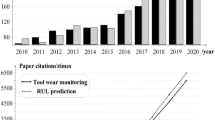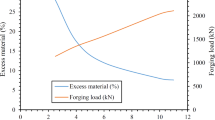Abstract
Disc-cutters play a crucial role in the penetration process during construction using a tunnel boring machine (TBM). Their wear status has a significant impact on working efficiency and costs that accounts for a large part of the budget. Discovering the wear pattern and characteristics of disc-cutters could provide a valuable guide for field maintenance and cutter replacement work. It also provides insight into the wear mechanism of cutters at different positions for optimizing the disc-cutter arrangement design. In this study, the cutter wears data of 34 disc-cutters over 643 days in the Chaoer River to Xiliao River water diversion tunnel was collected. The dataset contains 21862 manual readings measured from 1079 disc-cutters replaced in this project. The raw data from the hard copy version was transformed into a digital twin database by eliminating abnormal data, filling in empty values, and performing linear interpolations. It has been found that the cutters can pass statistical testing for an exponential probability distribution function with respect to the wear rate (w). The regression ratios of R2 are essentially greater than 0.8. These findings would help estimate the future service life of a currently working cutter, which means significant savings for the costly disccutters. The application of exponential distribution has the advantage of only one shape parameter, λ, whose reciprocal represents both the statistical mean and standard deviation of the wear rates. It is simple and practically amenable. A preliminary study was carried out to simulate the wear process between two neighboring cutters for drafting a replacement plan for disc-cutters by the Monte Carlo method. The prediction results agreed reasonably well with the measured information.
Similar content being viewed by others
References
Chen Z, Zhang Y, Li J, et al. Diagnosing tunnel collapse sections based on TBM tunneling big data and deep learning: A case study on the Yinsong Project, China. Tunn Undergr Sp Tech, 2020, 108: 103700
Karami M, Zare S, Rostami J. Tracking of disc cutter wear in TBM tunneling: A case study of Kerman water conveyance tunnel. Bull Eng Geol Environ, 2020, 80: 201–219
Yan F, Qiu W, Sun K, et al. Investigation of a large ground collapse, water inrush and mud outburst, and countermeasures during subway excavation in Qingdao: A case study. Tunn Undergr Sp Tech, 2021, 117: 104127
Yang H, Wang Z, Song K. A new hybrid grey wolf optimizer-feature weighted-multiple kernel-support vector regression technique to predict TBM performance. Eng Comput, 2022, 38: 2469–2485
Zhang Q, Su C X, Qin Q H, et al. Modeling and prediction for the thrust on EPB TBMs under different geological conditions by considering mechanical decoupling. Sci China Tech Sci, 2016, 59: 1428–1434
Karami M, Zare S, Rostami J. Introducing an empirical model for prediction of disc cutter life for TBM application in jointed rocks: Case study, Kerman water conveyance tunnel. Bull Eng Geol Environ, 2021, 80: 3853–3870
Wang L, Li H, Zhao X, et al. Development of a prediction model for the wear evolution of disc cutters on rock TBM cutterhead. Tunn Undergr Sp Tech, 2017, 67: 147–157
Ge Y, Liu Y, Lin P, et al. Effects of rock properties on the wear of tbm disc cutter: A case study of the yellow river diversion project, China. Int J Geomech, 2022, 22: 04022011
Sun Z, Yang Y, Chen K, et al. Disc cutter’s rock breaking ability and wear resistance in extremely hard rock: A case study in qinling tunnel of han river to wei river water diversion project. Geotech Geol Eng, 2019, 37: 4901–4910
Hamzaban M T, Rostami J, Dahl F, et al. Wear of cutting tools in hard rock excavation process: A critical review of rock abrasiveness testing methods. Rock Mech Rock Eng, 2022, 56: 1843–1882
Zhao Y, Yang H, Chen Z, et al. Effects of jointed rock mass and mixed ground conditions on the cutting efficiency and cutter wear of tunnel boring machine. Rock Mech Rock Eng, 2018, 52: 1303–1313
Yang H Q, Li Z, Jie T Q, et al. Effects of joints on the cutting behavior of disc cutter running on the jointed rock mass. Tunn Undergr Sp Tech, 2018, 81: 112–120
Rostami J, Ozdemir L, Bruland A, et al. Review of issues related to cerchar abrasivity testing and their implications on geotechnical investigations and cutter cost estimates. In: Rapid excavation and tunneling conference. Seattle, 2005. 738–751
Barzegari G, Khodayari J, Rostami J. Evaluation of TBM cutter wear in naghadeh water conveyance tunnel and developing a new prediction model. Rock Mech Rock Eng, 2021, 54: 6281–6297
Bruland A. Hard rock tunnel boring. Dissertation for the Doctoral Degree. Trondheim: Norwegian University of Science and Technology, 1998. 27–32
Zhang X, Xia Y, Zhang Y, et al. Experimental study on wear behaviors of TBM disc cutter ring under drying, water and seawater conditions. Wear, 2017, 392–393: 109–117
Gehring K. Prognosis of advance rates and wear for underground mechanized excavations. Felsbau, 1995, 13: 439–448
Yang Y, Hong K, Sun Z, et al. The derivation and validation of TBM disc cutter wear prediction model. Geotech Geol Eng, 2018, 36: 3391–3398
Wang L, Kang Y, Zhao X, et al. Disc cutter wear prediction for a hard rock TBM cutterhead based on energy analysis. Tunn Undergr Sp Tech, 2015, 50: 324–333
Liu Q, Liu J, Pan Y, et al. A wear rule and cutter life prediction model of a 20-in. TBM cutter for granite: A case study of a water conveyance tunnel in China. Rock Mech Rock Eng, 2017, 50: 1303–1320
Farrokh E, Kim D Y. A discussion on hard rock TBM cutter wear and cutterhead intervention interval length evaluation. Tunn Undergr Sp Tech, 2018, 81: 336–357
Lin L, Mao Q, Xia Y, et al. Experimental study of specific matching characteristics of tunnel boring machine cutter ring properties and rock. Wear, 2017, 378–379: 1–10
The National Standards Compilation Group of People’s Republic of China. Code for engineering geological investigation of water resources and hydropower (in Chinese). GB50487-2008. Beijing: China Planning Press, 2009, 262
Su W, Li X, Jin D, et al. Analysis and prediction of TBM disc cutter wear when tunneling in hard rock strata: A case study of a metro tunnel excavation in Shenzhen, China. Wear, 2020, 446–447: 203190
Zhang Z, Aqeel M, Li C, et al. Theoretical prediction of wear of disc cutters in tunnel boring machine and its application. J Rock Mech Geotechnical Eng, 2019, 11: 111–120
Balakrishnan K. Exponential Distribution: Theory, Methods and Applications. Amsterdam: Taylor & Francis Group, 2019. 7–14
Moré J J. The Levenberg-Marquardt algorithm: Implementation and theory. In: Watson G A, ed. Numerical Analysis. Lecture Notes in Mathematics, 630. Berlin, Heidelberg: Springer, 2006. 105–116
De Coursey W. Statistics and Probability for Engineering Applications. Burlington: Elsevier, 2003. 324–331
Kottegoda N T, Rosso R. Applied Statistics for Civil and Environmental Engineers. Chichester: Blackwell Publishing, 2008. 270–277
Bieniawski Z T. Engineering Rock Mass Classifications: A Complete Manual for Engineers and Geologists in Mining, Civil, and Petroleum Engineering. New York: John Wiley & Sons, 1989. 52–69
Singh B, Goel R K. Rock Mass Classification: A Practical Approach in Civil Engineering. Elsevier, 1999. 242–247
Li J B, Chen Z Y, Li X, et al. Feedback on a shared big dataset for intelligent TBM Part I: Feature extraction and machine learning methods. Underground Space, 2023, 11: 1–25
Li J B, Chen Z Y, Li X, et al. Feedback on a shared big dataset for intelligent TBM Part II: Application and forward look. Underground Space, 2023, 11: 26–45
Zhang Y P, Chen Z Y, Jin F, et al. Cross-project prediction for rock mass using shuffled TBM big dataset and knowledge-based machine learning methods. Sci China Tech Sci, 2023, 66: 751–770
Yang W, Zhao J, Li J, et al. Probabilistic machine learning approach to predict incompetent rock masses in TBM construction. Acta Geotech, 2023, doi: https://doi.org/10.1007/s11440-023-01871-y
Jing L, Li J, Yang C, et al. A case study of TBM performance prediction using field tunnelling tests in limestone strata. Tunn Undergr Sp Tech, 2019, 83: 364–372
Yan T, Shen S L, Zhou A, et al. Construction efficiency of shield tunnelling through soft deposit in Tianjin, China. Tunn Undergr Sp Tech, 2021, 112: 103917
Mu B, Yang W, Zheng Y, et al. Excavation rate “predicting while tunnelling” for double shield TBMs in moderate strength poor to good quality rocks. Int J Rock Mech Min Sci, 2022, 149: 104988
Author information
Authors and Affiliations
Corresponding author
Additional information
This work was supported by the National Natural Science Foundation of China (Grant Nos. 41831281, 42220104007 and 52079150), the Basic Research Project of the China Institute of Water Resources and Hydropower Research (Grant No. GE0145B022021), and the Core Research Project of Power Construction Corporation of China (Grant No. DJ-HXGG-2021-01).
Rights and permissions
About this article
Cite this article
Yang, W., Chen, Z., Wu, G. et al. Probabilistic model of disc-cutter wear in TBM construction: A case study of Chaoer to Xiliao water conveyance tunnel in China. Sci. China Technol. Sci. 66, 3534–3548 (2023). https://doi.org/10.1007/s11431-023-2465-y
Received:
Accepted:
Published:
Issue Date:
DOI: https://doi.org/10.1007/s11431-023-2465-y




